

Dealng With Resource Allocation and Overallocation. Written by: Ronda Bowen • edited by: Jean Scheid • updated: 9/19/2012 Your project's health often depends upon resource allocation.

Overworked employees and spending overtime on a project can be a nightmare. Avoid project pitfalls by dealing with resource overallocation before it affects your project's health. What is Resource Overallocation? Resource overallocation happens when assignments of more tasks than your resources can handle or reasonably complete within a standard eight hour workweek are assigned. When this happens, because your project health and resource allocation affect how teams work, both in-house and outsourced, your projects may stall, come to a complete stop or fail. Why Resource Allocation is Important. 3 Things Every Business Analyst Should Know about Agile. In the past few years, software development has been shifting more and more from traditional to agile practices.
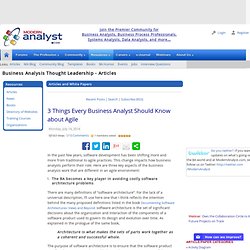
This change impacts how business analysts perform their role. Here are three key aspects of the business analysis work that are different in an agile environment: The BA becomes a key player in avoiding costly software architecture problems There are many definitions of “software architecture”. The Initial Conversation with Your Project Manager. As a business analyst (BA), what would you say during the initial conversation with your project manager (PM)?
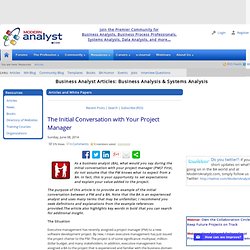
First, do not assume that the PM knows what to expect from a BA. In fact, this is your opportunity to set expectations and explain your value added to the project. The purpose of this article is to provide an example of the initial conversation between a PM and a BA. Note that the BA is an experienced analyst and uses many terms that may be unfamiliar; I recommend you seek definitions and explanations from the example references provided.The article also highlights key words in bold that you can search for additional insight.
3 Visual Models a New BA Should Know How to Use. In a recent article on the Top 10 Skills a New Business Analyst Should Shore Up On, #6 was identified as creating visual models.
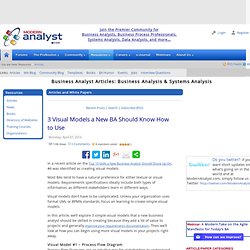
Most BAs tend to have a natural preference for either textual or visual models. Requirements specifications ideally include both types of information, as different stakeholders learn in different ways. Visual models don’t have to be complicated. Requirements Elicitation Technique – Tools of the Trade. As a BA, I’m always looking for tools that can help me with my job…anything to make my life just a bit easier!
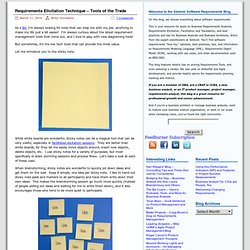
I’m always curious about the latest requirement management tools that come out, and I love to play with new diagraming tools! But sometimes, it’s the low tech tools that can provide the most value. Let me introduce you to the sticky note. While white boards are wonderful, Sticky notes can be a magical tool that can be very useful, especially in facilitated elicitation sessions. The Changing Shape of Business Analysis. Why Analysis and Design are Inseparable The traditional axiom in business analysis that there should be a “Berlin Wall” between analysis and design is being torn down these days.
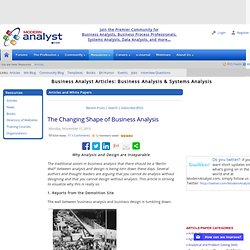
Several authors and thought leaders are arguing that you cannot do analysis without designing and that you cannot design without analysis.
It's All About Transactions. - Everything we do in systems and software involves the processing of transactions.
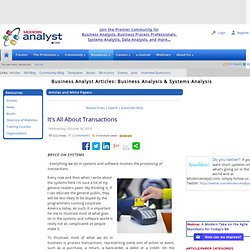
Every now and then when I write about the systems field I'm sure a lot of my general readers yawn. My thinking is, if I can educate the general public, they will be less likely to be duped by the programmers running corporate America today. As such, it is important for me to illustrate most of what goes on in the systems and software world is really not as complicated as people make it.
To illustrate, most of what we do in business is process transactions, representing some sort of action or event, such as a purchase, a return, a back-order, a debit or a credit. On the highways, counting the number of automobiles on the highway, tracking traffic signals, recording moving violations, or paying a toll. My programmer friends who write computer games believe this is nonsense.
Transactions can be processed either one at a time (as in "interactive") or in groups ("batch"). Keep the Faith! An Exercise in Documenting Current State: Reddit and the BDD. Introduction “Let’s be honest; someone knows how all this stuff works, right?”
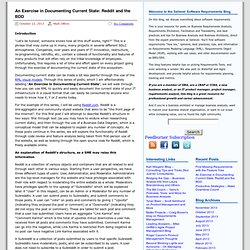
This is a phrase that may come up in many, many projects in several different SDLC atmospheres. Companies, over years and years of IT innovation, restructure, re-programming, retrofits, etc., contain a cobweb of functionality and features of many products that will often rely on the tribal knowledge of employees. Unfortunately, this requires a lot of time and effort spent on every project going through the exercise of documenting the current state of the ecosystem. Documenting current state can be made a lot less painful through the use of the RML visual models. For the example of this series, I will be using Reddit.com. What Goes Into a Functional Specification?
If you find yourself in a business analyst role on an IT project, it’s likely that at some point you’ll need to create a functional specification.
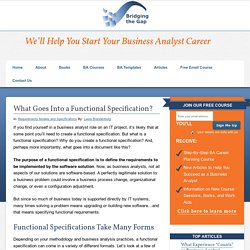
But what is a functional specification? Why do you create a functional specification? And, perhaps more importantly, what goes into a document like this? The purpose of a functional specification is to define the requirements to be implemented by the software solution. Now, as business analysts, not all aspects of our solutions are software-based. But since so much of business today is supported directly by IT systems, many times solving a problem means upgrading or building new software…and that means specifying functional requirements.
Functional Specifications Take Many Forms. How to Improve Your Meeting Facilitation Skills. In my most recent article on the Top 10 Skills a New Business Analyst Should Shore Up On, #1 on the list was facilitating meetings.
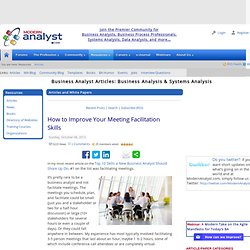
It’s pretty rare to be a business analyst and not facilitate meetings. The meetings you schedule, plan, and facilitate could be small (just you and a stakeholder or two for a half hour discussion) or large (10+ stakeholders for several hours or even a couple of days). Or they could fall anywhere in between. My experience has most typically involved facilitating 3-5 person meetings that last about an hour, maybe 1 ½-2 hours, some of which include conference call attendees or are completely virtual. In this article, we’ll look at 3 possible roles new BAs fill in meetings, how to expand your meeting facilitation experience, and review 5 critical meeting facilitation techniques that will help you run working, productive meetings.
The Roles New BAs Fill in Meetings No matter what role you start in, you’ll want to work towards the facilitator role. The Magic of Tabulation: How to Write Better Business Rules and Better Requirements. This article examines how to use tabulation to write better business rules. If you’re not writing business rules, well, you should be. Fortunately, the very same guidelines apply to writing requirements in general, so there is much to be gained on all fronts. Using lists of indented bullet items is called tabulation (after the keyboard tab key used to indent). Tabulation is a stylistic device commonly applied in legal and other forms of writing for simplification and clarity. Example of contractual provisions without tabulation [1] … For a one-year period after the Term, the Executive shall not employ any person who was an employee during the Term. Tabulated version … For a one-year period after the Term, the Executive a. shall not employ any person who was an employee during the Term; and b. shall not interfere with the relationship between the Company and any of its employees.
Measure Once, Cut Twice. If you read the title and thought to yourself, “Hey, Mulvey got it wrong, it’s ‘Measure Twice, Cut Once’” I’ll bet you have had an experience with someone who used the old woodworking term. Woodworkers use it to indicate it’s better to double-check your measurements before you commit to cutting the wood, lest you waste time redoing work (and incurring expense if you have to buy more wood). It’s a great proverb to get you to think about double-checking your work and confirming your measurements. But what I’m talking about is using the measurement as an enterprise asset – once you create the measurement, use that over an over when you are working on different projects. Consider a recipe you have at home. Every time you make chocolate chip cookies, you pull out the recipe box (or call it up on your iPad – we are in the 21st century after all) and look up the recipe. What is SWOT Analysis? What is SWOT Analysis?
SWOT is an acronym for Strengths, Weaknesses, Opportunities and Threats. By using these four areas to identify an organization’s characteristics and climate, a SWOT Analysis offers a high-level evaluation of your company’s pros and cons.The goal of a SWOT Analysis is to help an organization to identify strategies for success. It is generally displayed in a boxed matrix similar to this: Generally, strengths (such as the ability to change quickly) and weaknesses(such as a slow customer service response time) are internal to the organization, while opportunities and threats tend to be external (competition, regulations, market share, and so on).
While its high-level nature makes it generally not useful for in-depth analysis, SWOT Analysis has many applications. Check out some samples of SWOT analysis (minus the diagram) for well-known organizations here: Do I really need it? How to Analyze a Business Process. Do you find that your projects are looking for you to get closer to the business activities and that your normal set of requirements specifications are not holding up to the challenge?
Enhancing the 'A' in Business Analysis > Business Analyst Community & Resources. As Business Analysts, we have become pretty proficient with respect to requirements. Understanding the Who, What, Where, When and How to develop, document and manage requirements has seemingly become part of our DNA. But when it comes to performing analysis, the “how” unfortunately doesn’t come as natural. Whether you’re a BA generalist, specialist, or somewhere in between, our core competency should be the ability to effectively analyze things. By analyze, I mean possessing a level of proficiency to examine, interpret and transform information (implicit and explicit) that enables sound decision making. Get a Grip on Operational Business Decisions: Question Charts (Q-Charts™) > Business Analyst Community & Resources.
Humanizing Business Analysis: Visualizing Meaning through Business Concept Maps > Business Analyst Community & Resources. Business Analysis is the first link in the chain. The 7 Secrets of Good Business Analysts. What Business Analyst Skills are Important for a New BA? The Courage to Scribe Part 2. In Part 1, I discussed the role of the scribe, how the scribe and facilitator work together, and some of the critical skills that effective scribes need to turn the chaos of random discussions into the structure needed to develop the solution.
Don’t Forget the Forgotten Use Cases: Use Case template download. Chess and the Art of Business Analysis - Part 3. This is the third post in a series which compares world of the chess player with that of the business analyst using the BABOK (IIBA, 2009) Knowledge areas as a framework for the comparison. Post 1 looked at the knowledge area of Business Analysis Planning and Monitoring, whilst post 2 focused on Elicitation. Knowledge area 3: Requirements Management and Communication. 10 Key Business Analysis Trends For 2013 - Delivering Business Values Brings Business Analysis into the Limelight. How to Diagram a Workflow. Chess and the Art of Business Analysis Part 2. In Chess and the Art of Business Analysis Part 1, a number of analogies were drawn between the competencies needed for success in both the game of chess and the discipline of business analysis.
Using the framework of the BABOK (IIBA 2009) this post continues that discussion, this time framed by the activities described in the knowledge area of Elicitation. 3 Ways to Conduct Elicitation Even If You Aren’t in a Business Analyst Role > Business Analyst Community & Resources. Working with Remote Stakeholders? 3 Tips for Using Your Elicitation Skills Online. Requirements Reviews - When You Want Another Opinion - Part 1. The Courage to Scribe Part 1. Choosing the Right Software Requirements Models for Projects. Flash Points: Where Business Rules Meet Business Events. The forgotten art of “Document Analysis”
Defining Software Requirements to Handle Data Errors: Part 2. What Are the Contents of a Business Case? 5 Steps to Master Requirements Prioritization. Requirements Gathering vs. Elicitation. Starting in a new domain? Don’t Panic! 4 mistakes to avoid when leading a requirements meeting. Business Analyst Checkpoints: Checkpoint Beta. Business Analyst Tip for Using Visual Requirements Models. Requirements Models: Decision Trees and Decision Tables. Requirements Models: Decision Trees & Decision Tables Part 2. Software Requirements for Replacing Legacy Applications 4. The Top 5 Resources Every Aspiring BA Should Check Out ASAP. Business Analyst: The plumber of the organization? How to Make a SWOT Analysis. How to Use Your Customer Service Skills to Land a Business Analyst Job. Business Analyst Training: Defining YOUR Requirements.
Business Requirements Gathering: It’s Great to be Wrong. Dealing with the ‘How’ When You are Looking for the ‘What’ How do I convince my team to adopt better requirements practices? Three Ideas for Better User Requirements. The Process of Determining Business Requirements. Building the Security Model with Use Case and Class Models. How Business Processes, Strategy, and Business Policies Relate. What’s Really Needed to Align Business and IT Part 1: Creating True Business Solutions > Business Analyst Community & Resources.
Legacy System Retirement: Business Objectives Reduce Risks. Business Analyst Checkpoints: Checkpoint Alpha > Business Analyst Community & Resources. A Graphical Functional Specification - Part 1. The Five Most Important Differences BetweenThe Decision Model and Business Rules Approaches (They are not by accident!) How to Be a Successful Business Analyst Without Industry Domain Knowledge. The Rapid Research Method - J.D. Meier's Blog. Using the Business Architecture in Business Analysis > Business Analyst Community & Resources. COTS Software: Use Business Objectives, Reduce Project Risk. Optimal Decision-Making: Turning Data into Actionable Information. What’s Really Needed to Align Business and IT Part 2: Strategy for a Business Solution. Case Study: Using the Decision Model to Decompose Underwriting Calculations.
It’s a New World for the BA: We Need to Grow up Fast! The Great Facilitator. Facilitating virtual meetings.